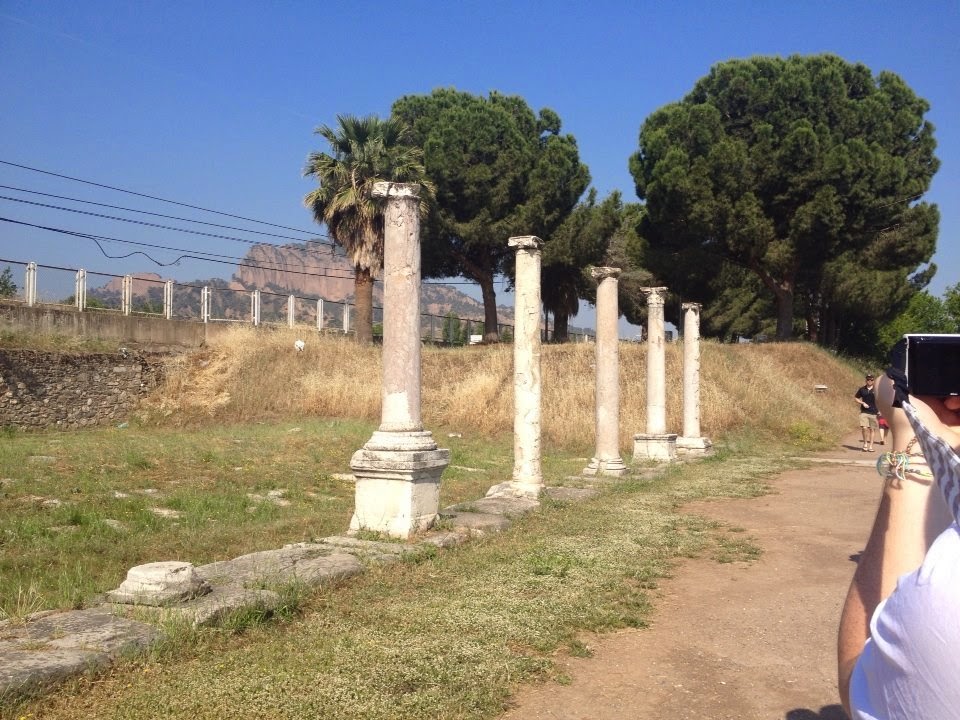Walking along Roman roads and
sitting in ancient theatres for the past week and a half has put all of our
studying into perspective. We know about the stories and the
journeys of some of the first Christians: about the preaching, sailing, writing,
and falling out of windows. But now we get to be here. We have the privilege of being in these ancient places and
standing on ancient stone. We even get a chance to visit all seven cities John wrote
to in the book of Revelation. And of all the places we have seen so far, Sardis
has really been the most unique.
Settled around 1400 BCE, Sardis is a fairly old city even by Turkey's standards. And it was a
strategic city. It functioned as a connection between Anatolia (basically all
of Turkey) and the Aegean coast (the body of water between Turkey and Greece). Sardis
also served as the capital of the Lydian empire. In an area rich in
resources—namely grapes and gold—it easily became one of the wealthiest cities
in the ancient world. The wealth of King Croesus (from whom we get the phrase
“as rich as Croesus”) came from the gold along the banks of the nearby Pactolus
River. Sardis was also strategic militarily—once thought to be an impregnable
fortress, it was only over overtaken by stealth. In 546 BC the Persians were
only able to take control of Sardis when a soldier accidentally exposed a secret entrance while retrieving his helmet that he dropped outside the city. Later, in 334 BCE, Alexander the Great took over Sardis from
the Persians where it also became the capital of the Selucid Empire.
When we entered Sardis, we walked
along a Roman road, a road that a major highway in Turkey still follows today.
This ancient Roman avenue moves from east to west and is made of
a layer of gravel, terra cotta, and stone, often marble. It is shaped like a
pyramid so that water doesn’t accumulate, making the path easier to traverse.
If that wasn’t enough, the gravel also helped to absorb the water.
Thanks to Cornell and Harvard,
archaeologists have been able to piece together what would have been the
gymnasium and the synagogue. The gymnasium and bath complex is a massive
structure that would have been used only by men for physical exercise
and for training for events such as running and fighting. The boys who
trained in these gymnasiums often turned into very good soldiers. The place in which
they would have exercised is the large open courtyard known as the palaestra.
Within the structure itself was where the bath was located, which consists of a
long, but shallow oval pool that would have once been filled with water. Along the outside of the palaestra used to be classrooms where the male students would go to their studies after a long
morning of exercise.
 |
| The entire gymnasium and bath complex with the palaestra (the grass area) in front |
 |
| The bath area--the students are walking in the oval pool |
The other major structure we saw was the
synagogue, which is thought to be the largest synagogue of the ancient world
outside of Israel. Sardis has a unique place in the history of Jews in Turkey.
In 220s BCE, nearly 2000 Jewish families moved into the area from Mesopotamia in order to provide more workers for the city. The second wave consisted of Sephardic Jews who
moved into the area in the 1490s due to religious persecution in Spain. The
third wave occured in the 1930s when Ataturk invited Ashkenazi Jews into Turkey.
 |
| The synagogue--note the wonderful floor mosaics |
When we walked into the synagogue,
there was an ancient Christian symbol etched into the stone
on the ground:
If you were to break it apart, the
wheel represents 5 Greek words, Jesus, Christos, Theos, Huios, and Soter, which
translates to Jesus, Christ, God’s Son, Savior. We can find the first letter of
each of these words in their Greek form hidden in the wheel. These words, in
turn, create the acronym Ichthus, which means fish in Greek. This symbol is closely related to what we call the Jesus fish, which was another ancient Christian symbol with a very similar meaning.
 |
| Here is my colorful attempt to show the hidden letters in the wheel |
As we sat in the synagogue, we had
the fortune of listening to Dr. Yeatts talk to us about the letter written to
the Sardis church in the book Revelation. It is quite amazing to be able to use our
knowledge of the history and geography of Sardis to understand the biblical
passage, For example, when John warns the church of Sardis in Revelation 3: 1-6 that “if you do not wake up, I will come like a thief, and you will not know at what time I will come to you,” we can
compare it to Sardis’ history as a city people once thought was invincible (Rev. 3:3). Like I mentioned above, Sardis was a city overtaken by stealth. In the same way, the church of Sardis needed to remain vigilant for Christ will come when they least expect him.



No comments:
Post a Comment